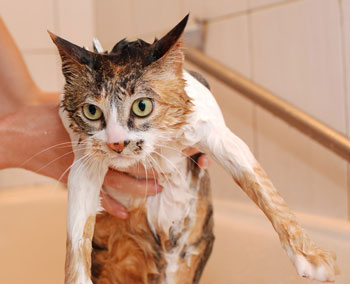How to Give a Cat a Bath

Cats are notorious for not liking to be bathed. While you will find certain individuals that seem to love water, you won't see too many cats volunteering for a bath or a swim.
Most of the time, cats don't need frequent bathing. They clean themselves well, and their skin can become too dry if bathed often, which can result in skin problems.
Still, there may be times when you will need to bathe your cat. If she's gotten a chemical or foul substance on her fur that you don't want her licking off herself and ingesting, you'll need to give her a bath.
Sometimes your veterinarian will prescribe medicated baths for certain skin conditions.
How to Bathe a Cat
If you do need to bathe your cat, here are some tips:
- If you already know that your cat hates baths and might fight you, it can help to have Soft Paws® on her claws beforehand, to minimize the chances that you'll be scratched. You won't be able to do this, of course, if it is an emergency clean-up of a chemical because the claw cap adhesive will need to dry for a bit before you can give your cat a bath.
- If it's not an emergency and your cat doesn't have Soft Paws® on, trim your cat's claws before the bath. This will decrease her chances of tearing one if she becomes agitated during the bath and also make them a bit less dangerous to you.
- If you can, tire your cat out with a play session and then a nice meal before you try to bathe her. This will help her be calmer.
- Place a non-slip mat or towel on the bottom of the sink or tub to minimize your cat's slipping.
- Fill a sink or tub with about 2 inches of warm water. Be sure to feel the water yourself, preferably on the inside of your wrist or elbow, to be sure it isn't too hot.
- Fill several large cups with water, too, so you won't have to run any water while your cat is in the tub. The running water often causes cats to panic.
Never yell at your cat or treat her harshly during a bath (or ever). This will cause her to be more stressed out about baths and harder to bathe in the future.
- When you bring your cat into the room to bathe her, close the door behind you so that if your cat escapes, you won't have to chase a wet, sudsy kitty all through your home.
- Use mild cat shampoo. Ask your veterinarian for a recommendation. Don't use human shampoo, which can dry your cat's skin out or contain toxic-to-cats ingredients. Don't use a medicated shampoo unless your veterinarian has prescribed it for your cat.
- Stay calm yourself. Cats are masters at reading humans' emotions, and if you're nervous, she will be, too.
- Wear a long-sleeved shirt or sweater to protect your arms.
- If there's another person to help you, have him gently hold your cat's scruff to calm her and keep her steady while you do the bathing.
- Speak soothingly and calmly to your kitty, and gently get her wet, using your cupped hands or the water in one of your cups, avoiding her ears and face.
- Gently massage the shampoo in, starting at the neck and working down to the tail.
-
Use your large cups of clean water to rinse her well.
- Wash your cat's face and head with a warm washcloth without shampoo.
- Use a towel to gently blot your cat as dry as possible, then brush her to further dry her and get any tangles out of her fur.
- Keep your kitty in a warm place free from drafts to finish drying.
- Give her a treat and lots of praise.
Get Your Cat Used to Baths Slowly if Possible
The best way to bathe your cat is to get her used to it slowly ahead of time. You can start by placing some cat toys in the empty tub and playing with your cat in there. Over time, you can slowly add water to the tub, continuing to play with her and make the tub a safe, fun place.
If your cat is used to the tub and to taking baths ahead of time, it will be much easier to effectively bathe her if she ever gets into a chemical and absolutely must be washed off.
You May Also Like These Articles:
How to Trim a Cat's Claws: VIDEO
Notice: Ask-a-Vet is an affiliated service for those who wish to speak with a veterinary professional about their pet's specific condition. Initially, a bot will ask questions to determine the general nature of your concern. Then, you will be transferred to a human. There is a charge for the service if you choose to connect to a veterinarian. Ask-a-Vet is not manned by the staff or owners of CatHealth.com, and the advice given should not delay or replace a visit to your veterinarian.





